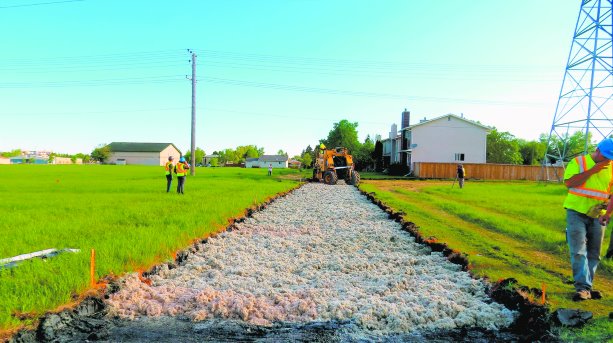A Winnipeg-based flooring contractor has found a use for old, worn carpet as a component in a soil stabilizer for the base of streets and roads.
The rationale for recycling old carpet goes beyond diverting it from the landfill stream, however.
"We are confident that this system will substantially reduce the frequency and extent of road maintenance and replacement," says Mike Kolas, president of Antex Western Ltd.
The stabilizer was developed by Antex’s sister company ACM (Alternative Cementitious Materials) Technology several years ago and patented this spring.
To date there have been two applications, a demonstration project for the City of Winnipeg on the Bishop Grandin Trail for pedestrians, cyclists and city vehicles and for a parking lot for Antex’s offices in Winnipeg.
Both jobs were done five years ago and are in "perfect condition" today, says Kolas, noting that other sections of the Bishop Grandin Trail paved at the same time without the stabilizer have been repaired several times since.
The trail project was monitored by a third party and a University of Manitoba research group.
Kolas says the cost of the parking lot was about the same as it would have been using a traditional gravel base.
"In the end we got something here that will last a lot longer and result in less maintenance," he claims.
When mixed with other components, the carpet fibres — which take centuries to biodegrade — help create a stabilizer with ductility or elasticity that prevents the soil from cracking, extending road durability.
The carpet fibres also control subsoil moisture to increase the hydration period of the "soil cement," Kolas says, adding recycled carpet is easy to create and inexpensive.
Traditionally, portland cement and/or lime are employed in a base to increase the compressive strength of soil in roadbuilding operations.
Kolas says subgrade stabilization can be suitable in new pavement construction (not just resurfacing) and based on one sample test the stabilized subgrade resulted in a 29 per cent reduction in sub-base thickness compared to the non-stabilized section.
In a flexible pavement design for existing pavement rehabilitation, the stabilized sub-base resulted in a 36 per cent reduction in base thickness compared to the non-stabilized design.
"This not only results in a cost reduction but greatly reduces the environmental impact of trucking the gravel base to and from the project site," he states.
While other soil stabilizers add compressive strength to subgrade, "they are very brittle," which led to cracking and moisture infiltration — a major cause of road deterioration during freeze-thaw cycles, he points out.
Kolas says while the stabilizer has yet to be specified for any road projects in Winnipeg, he believes it is inevitable that the product will find a market, if not under Winnipeg roads than under streets, highways, rural roads and parking lots in other areas across Canada and the U.S.
Trek Geotechnical Inc. was retained to conduct independent tests in the field and lab of the stabilizer on both of Antex’s projects.
Trek’s principal Nelson Ferreira sees the merits of the stabilizer in "frost susceptible" soils such as the soft clays of Winnipeg to improve the strength of the clay, thereby extending the life of the road. Ferreira says while the city has been able to obtain gravel from a local limestone quarry for granular base for its roads, it does not improve road performance as much as the stabilizer.
Furthermore, the quarry is being depleted. Using the soil stabilizer reduces the need for gravel, he says, "and you can get better performance."
The stabilizer might need "one or two more tests" to confirm its performance abilities, he adds.
The only downside, says Ferreira, is that the stabilizer requires "a lot of handwork" and a tiller attachment is used on a loader to conduct the work.
"It’s not overly expensive though."
Kolas says that of the 12 billion square feet of carpet manufactured in the U.S. annually less than five per cent of it is ever recycled. Canada’s recycling record is even worse.
As a flooring contractor, he has put "tens of thousands of tonnes of old carpet into landfill. I don’t feel very good about that. This is a very sustainable way of dealing with that problem."




Recent Comments
comments for this post are closed